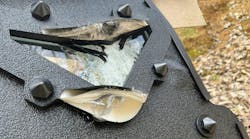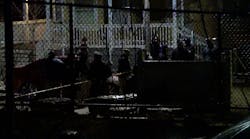Last week I got an email asking me my opinion about the militarization of law enforcement today. Then a few days ago I saw an article in the Wall Street Journal about the same topic. It seems that some people are concerned about the creation of a police state through the steady evolution of police and sheriff’s officers/deputies into domestic soldiers. The timing for the email and the article (for me) were perfect because I’ve been working on a project that centers around this very subject, and here’s my quick, simple response as to whether or not it’s a concern: Not at all. As long as our law enforcement professionals operate under the controls of the Constitution, it doesn’t matter how they dress or what equipment they use. Let me explain…
First, understand that a professional appearance is expected out of everyone in both fields of endeavor – and that makes sense. If you wear a uniform you should invest time daily to insure that you are fit. That means your physique will be better than the average person’s. That matters because your body and mind are your first and most important weapons in any conflict. No, I’m not saying police officers are all “weapons” first, but reality is that they can find themselves either under attack or having to act aggressively to protect and defend innocents, so being fit is necessary. Soldiers, no matter what their job, are in a career that may put them in harm’s way so being in shape is equally mandatory. This commonality of physical fitness combined with a clean cut grooming gives those in both fields a similar appearance.
Second, recognize that people in both fields HAVE to maintain an awareness of their environment. They are expected to respond to any potential threat in an efficient and motivated fashion. They can’t do so unless they first recognize a threat so they are trained to constantly be aware of their surroundings. This behavioral characteristic often makes them recognizable even if they aren’t in uniform and are off duty. Keep all that in mind as you read on.
If you traveled back in time to the mid-1960s and compared the uniforms of a police officer working the street to that of a soldier in a non-combat area you’d likely think that the police officer operated in the higher risk environment – and you’d be right. What about comparing a police officer to a combat soldier? At that time, with the exception of the rifle carried by soldiers you might not see a huge difference. Across the span of the next few decades (from then) both uniforms evolved, as did the equipment carried or worn.
Both uniforms evolved in a more practical fashion. Police uniforms became more comfortable (although some people seemed to feel that “more comfortable” meant less professional and/or formal in appearance). Instead of having to wear what amounted to a full suit, including tie and coat, in all seasons and climates, police officers have done the sensible thing and now can wear short sleeves when the season is appropriate, short pants depending on specialty assignment, etc. Many agencies make ties optional on midnight shifts when long sleeve shirts are worn. It’s become more about function than appearance although inspections are still held and standards do exist. For the soldier, the single color fatigue uniform has evolved into camouflage patterns in colors appropriate to branch of service. Dress uniforms are still dress uniforms.
So what’s changed that makes people think our domestic law enforcement professionals are becoming militarized? The answer is this: The equipment and weapons used in high risk situations. Where we in law enforcement begin to look more militaristic is in our special operations (SWAT) units. Body armor that’s heavier and worn outside the uniform; handguns in “tactical” (thigh) holsters; boots; helmets; goggles… and weapons that the public is more used to thinking about as soldiers’ weapons: rifles – specifically M16/M4 style weapons.
Is that a concern? No. It’s not. It’s common sense and, if you have a clue what you’re talking about, it’s of no concern at all. Any law enforcement officer who is carrying a patrol rifle (a semi-automatic box-fed rifle) has been properly trained and is taking that weapon into a situation where such firepower may be called for. Any law enforcement officer who is carrying a select-fire weapon (capable of firing multiple shots on a single pull of the trigger) has been properly trained (usually to a MUCH higher standard than required by law) and is taking that weapon into a situation where such firepower may be called for.
Let’s look at some other equipment people seem so worried about. How about armored vehicles? Do domestic police agencies have a need for an “armored car?” Yep. When you think about the situations they may have to face and the fact that they are required, in the course of their duties, to go into environments where bullets are or may be fired at them, having an armored vehicle only makes sense – unless you just want to get a bunch of officers needlessly wounded and/or killed. So why does it freak some people out that police agencies have armored vehicles? My guess would be because the public has been told by those who make their money off sensationalistic “news” generation that law enforcement using armored vehicles are “jack booted thugs enforcing a police state.”
Um, huh? A “police state” according to the Merriam Webster Dictionary is defined as:
a political unit characterized by repressive governmental control of political, economic, and social life usually by an arbitrary exercise of power by police and especially secret police in place of regular operation of administrative and judicial organs of the government according to publicly known legal procedures.
Now while there’s no doubt some of us believe that the federal government has intruded too far into our personal lives and business, there’s a huge difference between the federal government with its enforcement agents and our local police or sheriffs agency. No matter what we think or feel about the current government administration, your local law enforcement officers from the state level down are still controlled by and operate under the Constitution of the United States. They are also likely controlled by additional state laws, county regulations, city personnel laws and department policies. How does that compare to what rules soldiers operate under? The controls are vastly different. Military personnel in combat arenas operate under Rules of Engagement that can differ from area to area, commander to commander and mission to mission.
In the United States of America, from coast to coast, Alaska to Florida, Maine to Hawaii… sworn law enforcement officers have to operate within the restrictions as delineated in the Constitution. Do they always? No. They make mistakes. They’re all human. Occasionally there’s the “bad apple” that feels, for whatever reason, the law controlling his/her authority don’t apply and they do what they want instead of what’s legal. It happens. They get reported or a complaint gets filed. The investigation gets done. Upheld complaints result in appropriate disciplinary action.
But what we’re talking about, even if we didn’t realize it, is that a “police state” is created by the governmental authority that empowers the law enforcement professional. Police officers and sheriffs’ deputies themselves don’t create a police state. Their existence doesn’t equal the existence of a police state. Their behavior doesn’t automatically equate to the existence of a police state. What creates a police state is an oppressive arbitrary government – which can exist at any level: city, county, state or federal.
The thing to remember is this: appearance does not equal duty. A police officer wearing “soldier” gear is not a soldier. A SWAT team in an armored vehicle is not an infantry assault squad. A canine handler wearing a blue utility uniform is not a soldier – even though the uniform looks similar. He’s just wearing a uniform that is less expensive to replace when it gets damaged… and he’s wearing that because, as a canine handler, it’s more likely his uniform will get damaged/worn faster than the average officer’s will.
Think about it folks. Use your head. Quit swallowing the sensationalized clap trap fed by the mainstream – and often clueless – media.


